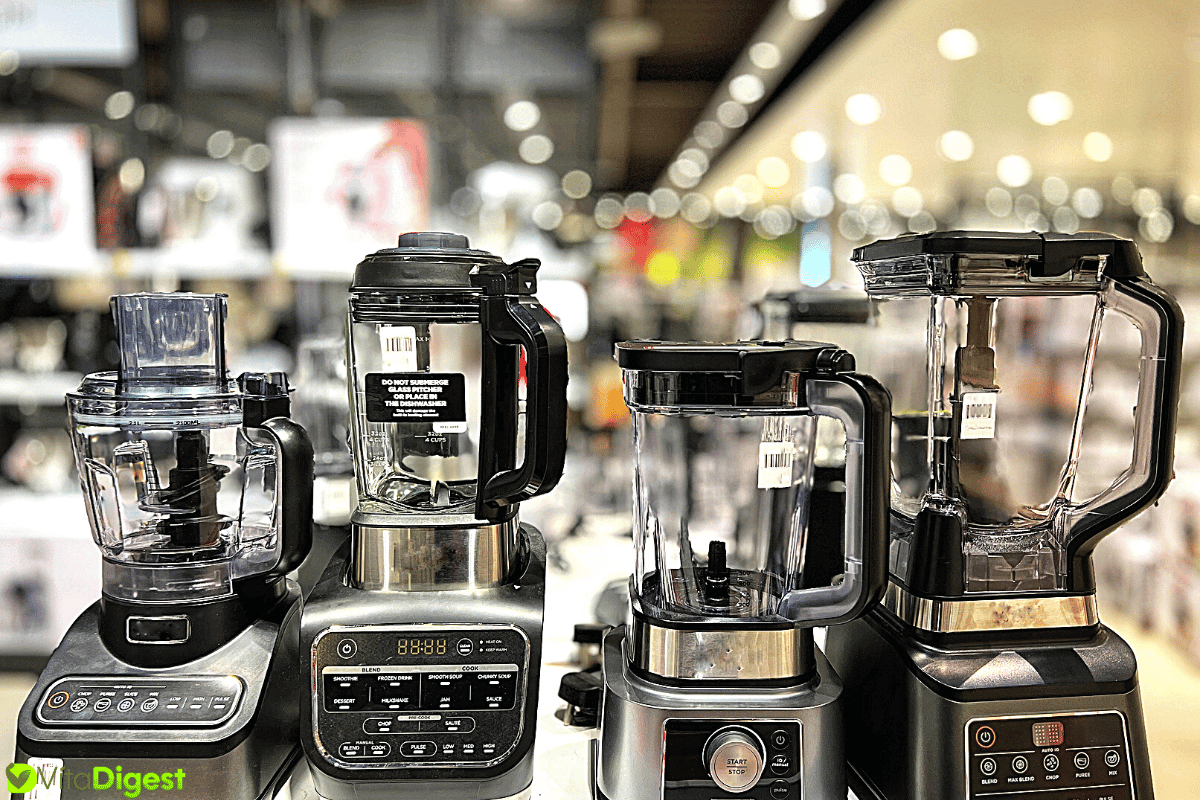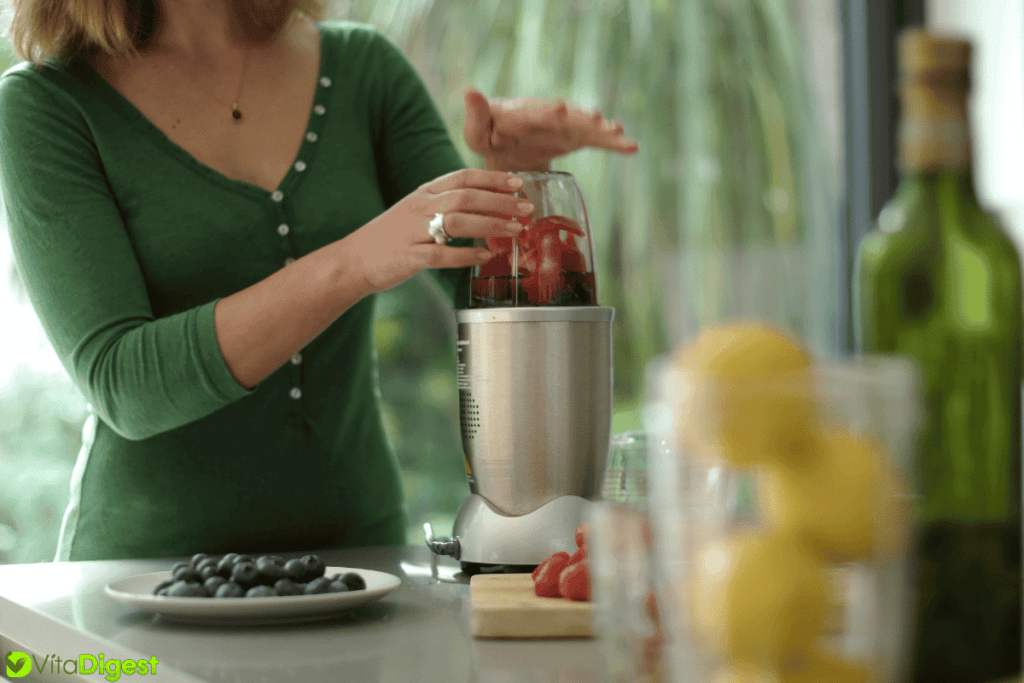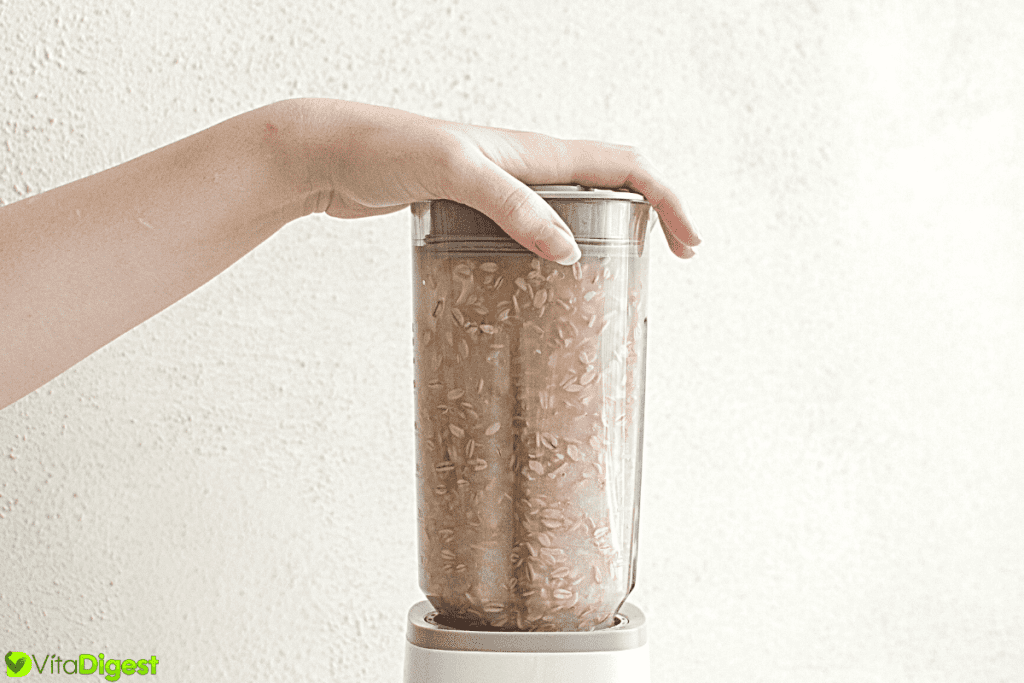When it comes to kitchen appliances, blenders are among the most versatile. They’re our go-to tool for smoothies, soups, sauces, and so much more. But not all blenders are created equal. There’s a wide range of types, each with its own strengths and weaknesses.
Immersion blenders, countertop blenders, personal blenders — the list goes on. We’re here to help you navigate this landscape and find the perfect blender for your needs. Whether you’re a smoothie enthusiast or a soup connoisseur, there’s a blender out there for you.
Understanding the different types of blenders can make your cooking experience more enjoyable and efficient. So, let’s dive in and explore the world of blenders together.
What are Blenders?
In the realm of kitchen appliances, blenders stand out as invaluable culinary aids. At their core, blenders are high-speed, motor-driven appliances designed to mix, puree, and emulsify food items. This precision tool comes in various forms, each ready to simplify your culinary tasks and elevate your cooking experience.
There are broadly four types of blenders: handheld or immersion, countertop, personal, and commercial. Their designs and capacities vary significantly, but they all share the common goal of making food preparation more convenient and efficient.
The handheld or immersion blender is a compact, handheld device perfect for blending soups and sauces right in the pot. Meanwhile, the countertop blender is a staple tool in many kitchens. It stands independently on your kitchen counter and can handle a range of tasks from making smoothies to grinding grains.
Shifting focus to the personal blender, it’s an ideal blend of practicality and portability. It’s able to whip up single-serving smoothies or protein shakes directly in a to-go cup. Last but not least, the commercial blender is a powerhouse appliance used in restaurants and cafes to fill high-volume orders.
By understanding what a blender is and the different types available, we can make informed choices. It’s not just about pulverizing food – it’s about enhancing flavors, textures, and overall meal enjoyment. As we delve into the differences between these types, we’ll see how they can each play a role in varying culinary scenarios. We want you to find the perfect blender for your needs, enhancing your cooking and eating experiences.
What Are The Different Types of Blenders?

In our quest to identify the perfect blender for our cooking and eating experiences, we will explore three popular types – countertop blenders, immersion blenders, and personal blenders.
Countertop Blenders
These are the most common types found in home kitchens. Countertop Blenders are powerful, versatile, and suitable for a wide range of tasks. Whether we’re looking to make creamy smoothies full of fruits and veggies or whip up a quick, hot soup, these blenders can handle it. Some models also come with multiple speed options allowing us to adjust the blending power to the type of food we’re processing.
Here are a few notable features of countertop blenders:
- Strong motor and sharp blades suitable for blending tougher ingredients like ice, nuts, and hard fruits
- Larger size provides more room for larger batches of food but also occupies more kitchen space
- Comes with numerous speed settings for flexibility
Immersion Blenders
Next, we have the Immersion Blenders. These are handheld devices perfect for blending foods directly in the pot or bowl. They’re convenient to use when we want to puree hot soup right on the stove or whisk pancake batter in a jiffy. Because they’re compact, they’re super easy to clean and store away.
Key characteristics of this blender type are:
- Lightweight handheld design for direct blending in pots, bowls or jars
- Ideal for small tasks and quick touch-ups
- The compact size makes it easy to clean and store
Personal Blenders
Finally, we have Personal Blenders. They’re named so because they are great for a serving of one. Ideal for quick smoothies and protein shakes, these blenders are small, so cleanup and storage are simple.
- Individual-size blender perfect for single servings and on-the-go meals
- Excellent for quick, small tasks like smoothies and protein shakes
- Easy to clean and store due to their compact size
Features to Consider

To make your blending experience smoother and more enjoyable, we’ve compiled a list of key features you should consider when choosing a blender. Ensuring that a blender meets your needs in these areas will make your kitchen tasks more efficient and your outcomes more delicious.
Power
When it comes to blenders, power is a crucial factor. The motor’s power determines how effectively a blender can chop, puree, or liquefy ingredients. For instance, countertop blenders typically come with a strong motor, allowing them to tackle a wide variety of heavy-duty tasks such as crushing ice or processing raw vegetables. Personal blenders, on the other hand, may have less power but are perfectly capable of handling softer ingredients like ripe fruits or yogurt for your smoothies.
Power is typically measured in watts, with most blenders ranging anywhere from 200 to 1,500 watts. Remember, a higher wattage equates to more power.
Speed Settings
Speed settings on a blender become handy depending on what you are blending. The capability to adjust the speed provides control over the texture and consistency of the processed food. While a fast speed blends and purees quickly, a slower speed is suitable for tasks where you want more texture in the final result, e.g., making salsas or chopping onions.
Container Size
Before deciding on a blender, consider the quantity of food or drink you typically process at a time. If you regularly host parties or have many mouths to feed, you might need a blender with a larger container. Conversely, if you often blend individual servings, a smaller blender may suffice.
Countertop blenders generally have large containers, mostly made of glass or plastic, and can hold between 5 to 14 cups. On the contrary, personal blenders are more compact with a much smaller capacity, typically up to 4 cups.
Blade Material
Blades are an integral component of a blender. They need to be robust enough to handle what you blend. The best blender blades are made from stainless steel due to its high resistance to rust and its strength for crushing hard items.
Keep in mind, though, that sharp blades aren’t necessarily better. In reality, many high-end blenders use blades that are blunt yet powerful, reducing the chance of injury during cleanup without compromising performance.
Considering these features, choose a blender that not only suits your budget but also amplifies your cooking experience by saving time and creating astounding recipes. Don’t hesitate to invest in a blender that brings convenience to your kitchen routines, and lets food preparation feel less of a chore. After all, isn’t that what the best kitchen appliances should do?
Best Types of Blenders For Smoothies?

When it comes to making smoothies, it’s critical to use a blender that’s powerful enough to pulverize even the toughest ingredients like frozen fruit, kale, and ice. Remember, no one wants to drink a lumpy smoothie or juice!
High-performance Countertop Blenders are an ideal choice for smoothies. They’re powerful – offering up to 2 horsepower! With sharp blades and a strong motor, they can easily handle heavy-duty blending. Fruits and vegetables don’t stand a chance against these blenders. Brands like Vitamix and Blendtec are commonly favored in this category.
Size is another thing to consider when shopping for a smoothie blender. For big families or smoothie enthusiasts, we recommend large-capacity blenders. They can handle quite a lot, making multiple servings in a single go. The Oster Dual Action Blender boasts a 6-cup capacity, a perfect pick for smoothie lovers.
Next up, we have Personal Blenders. They are an excellent choice for people who are often on the go. With their compact design, personal blenders can quickly whip up a smoothie right in the travel cup! You blend, drink, and run! Brands like NutriBullet and Ninja Fit are popular in this category due to their ease of use and performance.
Immersion Blenders might be seen as an unusual choice for smoothies, but they make the cut for their convenience and versatility. They’re ideal for blending soft ingredients and can be a good fit for smoothie bowls or soft-fruit smoothies. Though not as powerful as other blenders, they can still provide a smooth consistency when used properly.
So, in the quest to make the perfect smoothie, it’s important to choose the right blender. It needs to suit your lifestyle, capacity needs, and power requirements.
Let’s give a look at blender statistics in the table below:
| Blender Type | Ideal Use Case | Popular Brands |
|---|---|---|
| High-performance Countertop Blender | Heavy-duty blending, Large batches | Vitamix, Blendtec |
| Large Capacity Blender | Large batches, Family use | Oster |
| Personal Blender | Single servings, On-the-go use | NutriBullet, Ninja Fit |
| Immersion Blender | Soft fruits, Single servings | Braun, Cuisinart |
Can a blender be used as a mixer?
Certainly, the question of whether a blender can double as a mixer is one commonly asked. To provide an insightful answer, it’s essential we delve into the core differences between these two kitchen appliances.
Traditionally, blenders are designed for tasks that involve a liquid component. That’s why we love them for smoothies, purees, or milkshakes. Due to their high-speed blades, they are excellent at creating a consistent texture when blending a variety of ingredients, even harder ones like frozen fruits or ice cubes. On the other hand, mixers excel in combining dry ingredients. If you’re making bread or cookies, a mixer can knead dough or cream butter and sugar, tasks that are nearly impossible for a blender.
But that’s not to say blenders can’t be used as mixers. The versatility of certain types of blenders allows for some mixing functionalities. For instance, a high-powered countertop blender or an immersion blender with whisk attachments can replicate some uses of a mixer, such as whipping cream or eggs. Yet, it’s important to remember that although blenders can help with some mixing tasks, they won’t replace a mixer entirely.
Let’s look at a few instances occasioned by the performance and functionality of these appliances:
| Function | Blender | Mixer |
|---|---|---|
| Mixing dry ingredients | No | Yes |
| Whipping cream | Yes (with whisk attachment) | Yes |
| Combining liquids and solids | Yes | Yes (with certain attachments) |
| Kneading dough | No | Yes |
As we can see, a blender can certainly cover some uses of a mixer, particularly when it comes with a variety of attachments. However, for someone who frequently bakes or works with thicker doughs, a dedicated mixer would be more efficient.
Understanding the strengths and limitations of these gadgets will help us use our kitchen tools to their fullest potential, helping create delightful dishes with minimal effort. Because after all, it’s about getting the right tools for the job to make our cooking adventures more enjoyable and our kitchens more efficient.
Specialty Blenders
Specialty blenders embody the concept of diversity in the kitchen appliance world. These are targeted devices meant to perform specific tasks with ease and precision. Every specialty blender has unique characteristics, but they all strive to outshine the traditional blender with their special capabilities.
Immersion Blenders
Immersion blenders, fondly called stick blenders, are hand-held devices with a lean, compact design. The effortless control they offer is hard to match. They allow us to blend directly in the cooking pot or container, saving us from the mess of transferring hot soups or sauces to a traditional blender.
But how do these immersion blenders bring nutritional value to the table? They are particularly adept at retaining the fiber content found in fruits and vegetables, ensuring your meals are fiber-rich.
Personal Blenders
Most people lead busy lives, always on the move, and personal blenders fit into this lifestyle effortlessly. They pack quite a punch in their compact form. With usually single-serving jars that double as travel mugs, personal blenders make sure your nutrition doesn’t take a backseat, no matter how rushed you might be.
Worth noting, they are perfect for blending protein shakes or nutrient-packed smoothies, ensuring your diet remains balanced even with limited meal prep time.
Smoothie Blenders
If we talk about specialty blenders without mentioning smoothie blenders, it’s an incomplete story. Smoothie blenders are designed to blend frozen fruits, ice, and other hard ingredients to create that perfect smoothie consistency.
Smoothies prepared with these blenders can be incredibly nutritious, often packed with vitamins A and C, protein, and fiber. Even better, they help the body absorb these nutrients more effectively. There are numerous types of smoothies to be made, some for specific conditions like fasting, pregnancy, dietary needs, and more.
Soup Blenders
Last, but definitely not least, stand the soup blenders. As the name suggests, these blenders specialize in creating creamy, velvety soups without having to transfer hot liquid back and forth from the stove to the blender.
Besides their obvious convenience, they work wonders in breaking down vegetables, making nutrients such as Vitamins B and K more available to our bodies.
Understanding these specialty blenders, their function, and the unique nutritional value they bring, helps us make informed decisions about what kitchen tool is right for us.
Choosing the Right Blender
When it comes to finding the perfect blending companion for your kitchen, several factors must be considered. We’ll arm you with the crucial knowledge you need to make the right choice. Let’s dive in.
Budget
The first step in selecting the ideal blender is setting a budget. Quality blenders are available in a diverse range of prices. A good blender doesn’t have to break the bank. You can find dependable, high-functioning models that cost significantly less than their premium counterparts. Determine how much you’re willing and able to spend before you start shopping. This can help narrow down your options and keep your search manageable.
Needs and Preferences
Understanding your primary needs and preferences is key to making the right blender choice. If you’re a smoothie lover, opt for a blender that can handle frozen fruits such as a smoothie blender. For soup makers, a soup blender that can effectively blend and heat your culinary creations is optimal. If convenience is king, you’ll appreciate the hand-held versatility of an immersion blender. Likewise, if you’re constantly on the move, a personal blender is compact and easy to transport.
Durability and Warranty
Finally, you must consider a blender’s durability and the manufacturer’s warranty. Good blenders showcase robust, user-friendly design and construction. A reliable warranty reflects the manufacturer’s confidence in their product’s longevity. While it’s easy to be swayed by sleek design or advanced features, always ensure the blender meets your expectations of durability.
When considering a blender’s durability, pay attention to the make and materials. Stainless steel blades, for example, are a sign of a long-lasting blender. Similarly, the quality of the jug or container is essential – thicker, high-quality plastic or glass tends to indicate a more durable product.
It’s also wise to check a manufacturer’s warranty details. Comprehensive warranties that offer replacement or repair for any potential issues can provide additional peace of mind when making your final blender selection.
While selecting the perfect blender may seem daunting at first, it’s about understanding your needs, preferences, and budget, and finding a product that aligns with these factors. Make sure to consider durability and warranty, as these are also definitive indicators of a blender’s quality and your satisfaction in the long run.
What To Digest
We’ve walked you through the journey of selecting the perfect blender for your kitchen. From setting a budget to understanding your unique needs and preferences, we’ve covered all the bases. We’ve stressed the importance of durability and warranty, highlighting the value of stainless steel blades and high-quality containers. We hope you now feel equipped to make an informed decision and find a blender that’s not just a fit for your kitchen, but a match for your lifestyle. Remember, it’s crucial to know how long juice and smoothies are good for to ensure you consume your drinks when they’re at their peak in flavor and nutrition.
Frequently Asked Questions
What is the first step in choosing a blender?
The first step in choosing the right blender for your kitchen is setting a budget. Quality blenders are available at various prices; hence, understanding your financial limits is important.
What factors should I consider based on my preferences?
Your preferences also matter when choosing a blender. Whether you’re a smoothie lover, a soup maker, or someone who prefers convenience should influence your decision.
Why is durability important in a blender, and how can I determine it?
Durability is crucial as it determines the blender’s lifespan. More durable products usually have stainless steel blades and high-quality containers.
What should I know about the warranty of a blender?
A warranty offers extra peace of mind. You need to check the manufacturer’s warranty details, such as its duration and what it covers, before buying a blender.

3 thoughts on “A Guide to the Different Types of Blenders”
Comments are closed.